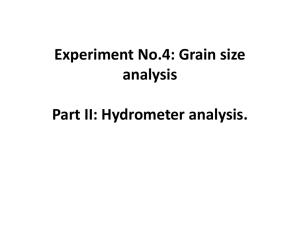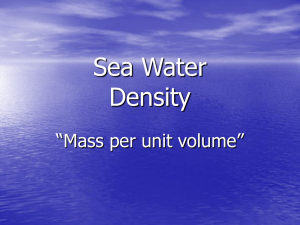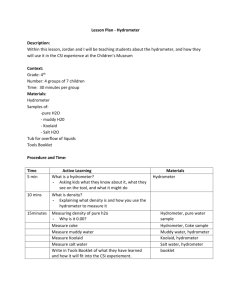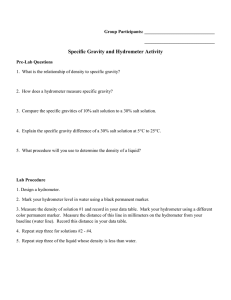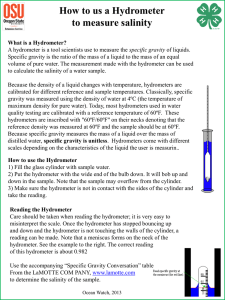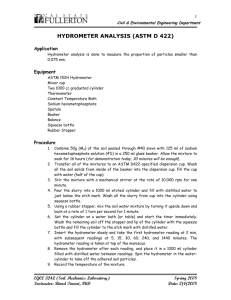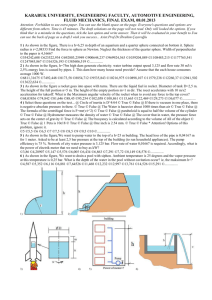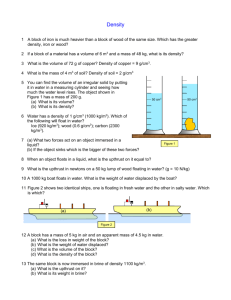Hydrometer_Build
advertisement
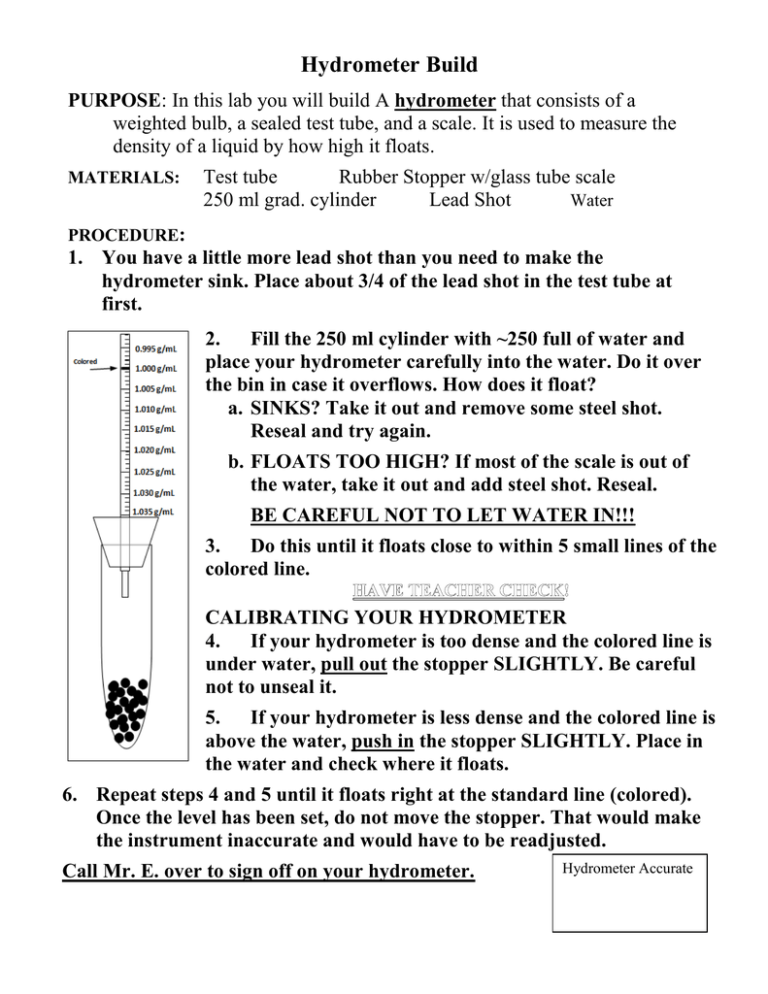
Hydrometer Build PURPOSE: In this lab you will build A hydrometer that consists of a weighted bulb, a sealed test tube, and a scale. It is used to measure the density of a liquid by how high it floats. MATERIALS: Test tube Rubber Stopper w/glass tube scale 250 ml grad. cylinder Lead Shot Water PROCEDURE: 1. You have a little more lead shot than you need to make the hydrometer sink. Place about 3/4 of the lead shot in the test tube at first. 2. Fill the 250 ml cylinder with ~250 full of water and place your hydrometer carefully into the water. Do it over the bin in case it overflows. How does it float? a. SINKS? Take it out and remove some steel shot. Reseal and try again. b. FLOATS TOO HIGH? If most of the scale is out of the water, take it out and add steel shot. Reseal. BE CAREFUL NOT TO LET WATER IN!!! 3. Do this until it floats close to within 5 small lines of the colored line. CALIBRATING YOUR HYDROMETER 4. If your hydrometer is too dense and the colored line is under water, pull out the stopper SLIGHTLY. Be careful not to unseal it. 5. If your hydrometer is less dense and the colored line is above the water, push in the stopper SLIGHTLY. Place in the water and check where it floats. 6. Repeat steps 4 and 5 until it floats right at the standard line (colored). Once the level has been set, do not move the stopper. That would make the instrument inaccurate and would have to be readjusted. Call Mr. E. over to sign off on your hydrometer. Hydrometer Accurate Hydrometer Build PURPOSE: In this lab you will build A hydrometer that consists of a weighted bulb, a sealed test tube, and a scale. It is used to measure the density of a liquid by how high it floats. MATERIALS: Test tube Rubber Stopper w/glass tube scale 250 ml grad. cylinder Lead Shot Water PROCEDURE: 1. You have a little more lead shot than you need to make the hydrometer sink. Place about 3/4 of the lead shot in the test tube at first. 2. Fill the 250 ml cylinder with ~250 full of water and place your hydrometer carefully into the water. Do it over the bin in case it overflows. How does it float? a. SINKS? Take it out and remove some steel shot. Reseal and try again. b. FLOATS TOO HIGH? If most of the scale is out of the water, take it out and add steel shot. Reseal. BE CAREFUL NOT TO LET WATER IN!!! 3. Do this until it floats close to within 5 small lines of the colored line. CALIBRATING YOUR HYDROMETER 4. If your hydrometer is too dense and the colored line is under water, pull out the stopper SLIGHTLY. Be careful not to unseal it. 5. If your hydrometer is less dense and the colored line is above the water, push in the stopper SLIGHTLY. Place in the water and check where it floats. 6. Repeat steps 4 and 5 until it floats right at the standard line (colored). Once the level has been set, do not move the stopper. That would make the instrument inaccurate and would have to be readjusted. Call Mr. E. over to sign off on your hydrometer. Hydrometer Accurate Hydrometer Analysis LABS/PROJ _____________________________ ______ NAME PERIOD Answer the following questions about your hydrometer. 1. The density of the test tube, lead shot, and rubber stopper are all higher than water and sink by themselves. What causes the hydrometer to float? 2. What two changes in density would cause the hydrometer to float HIGHER? Hydrometer - MORE or LESS Liquid - MORE or LESS 3. When a substance changes density, that means that either mass and/or volume must be changing. Explain if mass, volume, or both are changing when the hydrometer’s density gets… Higher density by adding lead shot. _______________________________ Lower density by pulling stopper out. _______________________________ Higher density by pushing stopper in. _______________________________ 4. How accurate is the hydrometer? 1.000 B A 5. What would the units of density be if the mass were grams and the volume milliliters? 1.005 1.010 1.015 D 1.020 1.025 C 1.030 1.035 6. Look at the diagram to the left. The lines running across the box represent water levels with a prominent meniscus. What would be the density for the following water samples? Be sure to include units! A. B. C. D.
